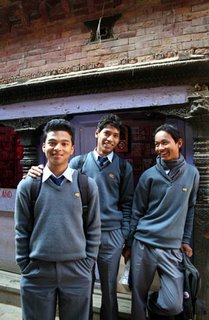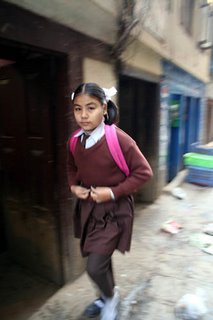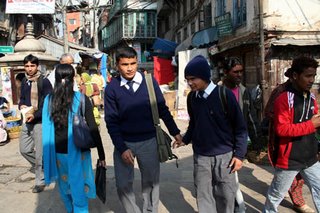Thursday, December 28, 2006
Travel Article on NYT
Many thanks to Satiprasad who pointed out this travel story on Bangladesh in NY Times. Nice to get the coverage.
Saturday, December 23, 2006
Which Language to Write
I was reading writer Mahmud Rahman's blog, where he discusses the language one chooses to write in, and its relationship to one's mother tongue. He approaches the issue from a writer's point of view - that is, the special problems that the writer faces when his or her mother tongue is different from the language that he or she chooses to write in. A fascinating topic.
That's a writer's dilemma, of course, but every time I write something in English - that, say, gets published in the Daily Star - something else bugs me: that the vast majority of educated Bangladeshis will not be able to read what I have written because they are educated in Bangla.
So for me, the big question is: who is the audience I write for? That is the basic question that I think many creative people must grapple with. In the subcontinent, Mulk Raj Anand and R. K. Narayan were the two early successful novelists in English - but look at what happened to Michael Madhusudan Dutta.
If you are a creative person, perhaps you have some thoughts? I have heard arguments that Satyajit Ray's Pather Pachali was really meant for a Western audience. But I have also read about Ray vehemently denying it. More importantly, can one argue that there ought to be a moral bias towards a particular type of audience the work of art is created for?
I have no confusion about who I write on this blog for. It is meant for our friends in the US, as well as anyone else, who is interested in the experiences of a returning NRB. As such, English is the way to go. But I also feel some loss at not being able to write as fluently in Bangla as I once did. My Bangla, as they say, "aRoshTo hoye gechhey." Something I want to fix in the future, definitely.
That's a writer's dilemma, of course, but every time I write something in English - that, say, gets published in the Daily Star - something else bugs me: that the vast majority of educated Bangladeshis will not be able to read what I have written because they are educated in Bangla.
So for me, the big question is: who is the audience I write for? That is the basic question that I think many creative people must grapple with. In the subcontinent, Mulk Raj Anand and R. K. Narayan were the two early successful novelists in English - but look at what happened to Michael Madhusudan Dutta.
If you are a creative person, perhaps you have some thoughts? I have heard arguments that Satyajit Ray's Pather Pachali was really meant for a Western audience. But I have also read about Ray vehemently denying it. More importantly, can one argue that there ought to be a moral bias towards a particular type of audience the work of art is created for?
I have no confusion about who I write on this blog for. It is meant for our friends in the US, as well as anyone else, who is interested in the experiences of a returning NRB. As such, English is the way to go. But I also feel some loss at not being able to write as fluently in Bangla as I once did. My Bangla, as they say, "aRoshTo hoye gechhey." Something I want to fix in the future, definitely.
Saturday, December 16, 2006
Monday, December 11, 2006
Baikka Beel (Photos)
Baikka Beel is a wildlife sanctuary in the Hail Haor wetlands near Srimongol. It is a USAID-funded project. I bicycled there yesterday. Here are some pictures.
The sign on the main MoulviBazar-Srimongol road is to your right if you are coming from MB, about 0.5 km past Bhairabganj Bazar:
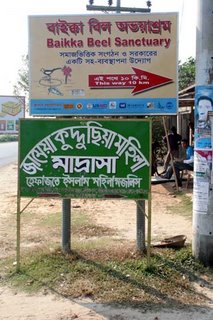
On the road I ran into fishermen returning from the haor with fish...

... as well as water buffaloes, whose milk is rich and flavorful...

... not to mention grandma who was out shopping with granddaughter...

...but this horseman was a surprise.

After about an hour of cycling from the main road, there was this explanatory sign...

...and an observation tower with incredible views from the top.
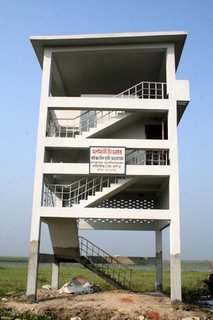
On the tower, Ujjol - one of the caretakers - points out some birds...
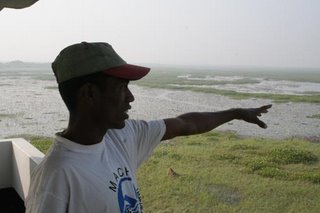
... of which there were thousands...
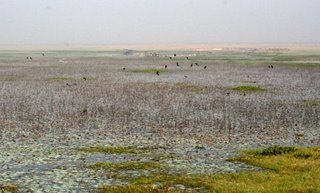
...and thousands.

Another view from the tower...

As I started back I saw the field was full of cobwebs reflecting morning light.

An excellent morning of exploration. My thanks to the sponsors and organizers of this project, which provides sanctuary for 98 types of fish and 160 types of birds. I will certainly visit it again, Inshallah.
The sign on the main MoulviBazar-Srimongol road is to your right if you are coming from MB, about 0.5 km past Bhairabganj Bazar:

On the road I ran into fishermen returning from the haor with fish...

... as well as water buffaloes, whose milk is rich and flavorful...

... not to mention grandma who was out shopping with granddaughter...

...but this horseman was a surprise.

After about an hour of cycling from the main road, there was this explanatory sign...

...and an observation tower with incredible views from the top.

On the tower, Ujjol - one of the caretakers - points out some birds...

... of which there were thousands...

...and thousands.

Another view from the tower...

As I started back I saw the field was full of cobwebs reflecting morning light.

An excellent morning of exploration. My thanks to the sponsors and organizers of this project, which provides sanctuary for 98 types of fish and 160 types of birds. I will certainly visit it again, Inshallah.
Tuesday, December 05, 2006
What Does Catman Do?
Years ago when I was new to Unix, I was having trouble understanding the man page for "catman" command. So I asked another engineer, Steve, "What does catman do?" and he said, "It is the capital of Nepal." Heh heh.
Last week I visited Kathmandu for the first time to accompany my son's school basketball team - my son plays in that team - competing in a regional tournament. They won the championship competing against schools from Delhi, Kathmandu, Colombo, Bombay, Lahore, Karachi, Islamabad and Murree. Congrats Tigers!
Kathmandu was interesting, but also raised troubling questions. They have a huge tourism industry, but where do the tourist dollars go? Talking to some locals, I got the impression the people are very poor. But incredibly nice, friendly and they liked Bangladesh a lot. A lawyer I met during lunch at a local hole-in-the-wall told me that the years of Maoist insurgency had really drained the economy.
I was in KTM the whole time, but if you go on a trek, for $30-$50/day/person you get guide+porter, lodging at "tea houses" and food. What kind of food? The guide shows you a menu and you choose what you want to eat and they cook or order it for you. Wow! Luxury in the mountains. Far cry from the gorp-and-freeze-dried sustenance I endured while backpacking in the Sierra Nevada.
Here is what really bugs me. So these mountains are their country. Yet, the poor Nepalese do the grunt work while foreign tourists explore the mountains like lords. Hardly seems fair, does it?
Last week I visited Kathmandu for the first time to accompany my son's school basketball team - my son plays in that team - competing in a regional tournament. They won the championship competing against schools from Delhi, Kathmandu, Colombo, Bombay, Lahore, Karachi, Islamabad and Murree. Congrats Tigers!
Kathmandu was interesting, but also raised troubling questions. They have a huge tourism industry, but where do the tourist dollars go? Talking to some locals, I got the impression the people are very poor. But incredibly nice, friendly and they liked Bangladesh a lot. A lawyer I met during lunch at a local hole-in-the-wall told me that the years of Maoist insurgency had really drained the economy.
I was in KTM the whole time, but if you go on a trek, for $30-$50/day/person you get guide+porter, lodging at "tea houses" and food. What kind of food? The guide shows you a menu and you choose what you want to eat and they cook or order it for you. Wow! Luxury in the mountains. Far cry from the gorp-and-freeze-dried sustenance I endured while backpacking in the Sierra Nevada.
Here is what really bugs me. So these mountains are their country. Yet, the poor Nepalese do the grunt work while foreign tourists explore the mountains like lords. Hardly seems fair, does it?
Subscribe to:
Comments (Atom)










